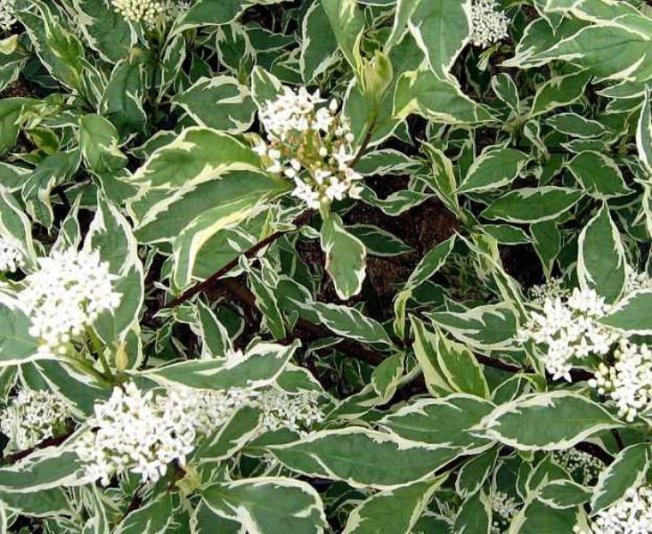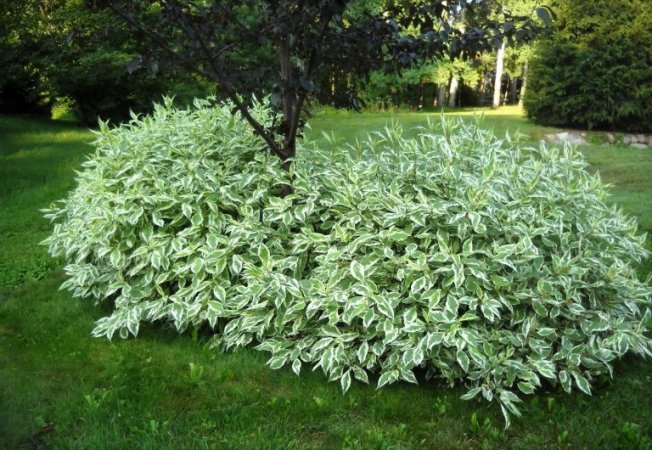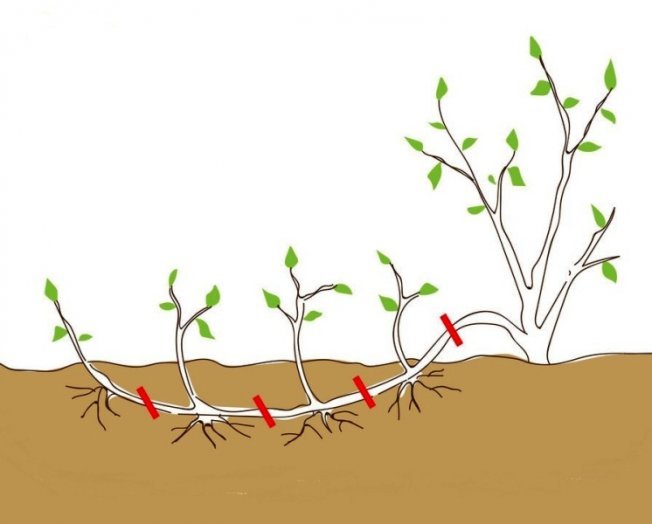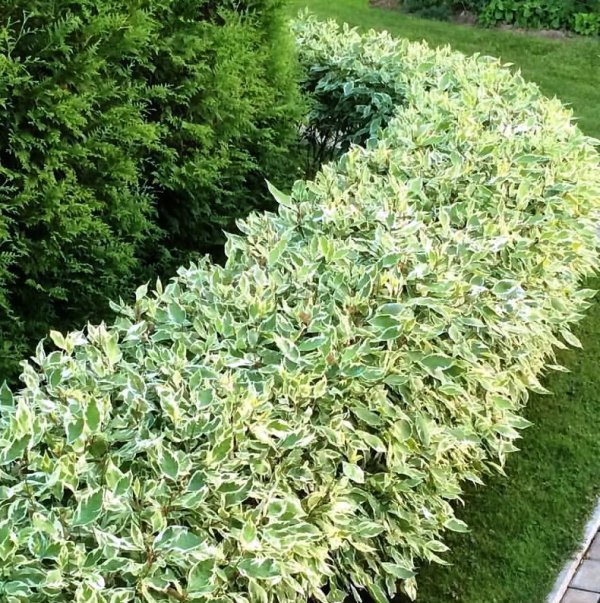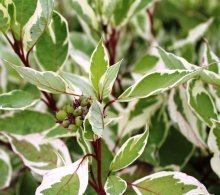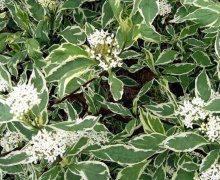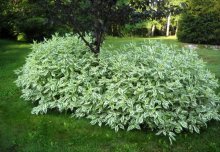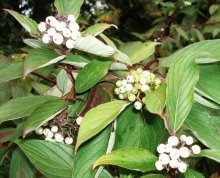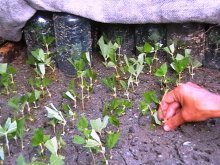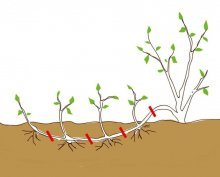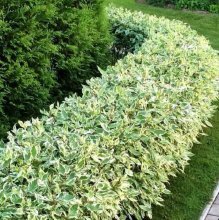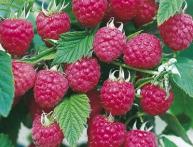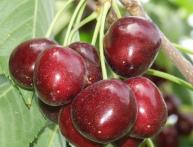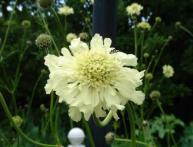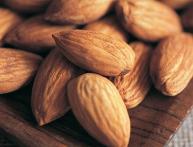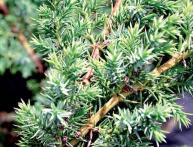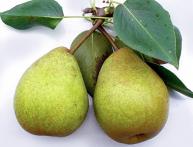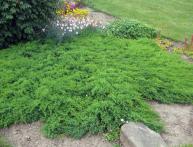White derain elegantissima, description and photo, when and how to plant, rules for caring for shrubs
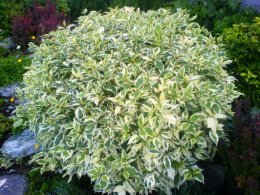
Among the ornamental shrubs used to create hedges, white elegantissima turf occupies a special place.
Frost-resistant and unpretentious Elegantissima is perfect for growing in the northern regions.
Content:
- White derain elegantissima, description and photo, as it is called in Latin
- White dogwood, where to buy, terms and rules of planting
- Features of Elegantissima turf care: watering, fertilizing
- Pruning, principle of crown formation
- Reproduction by cuttings, seeds, layering
- Pests and diseases: control and preventive measures
- How to preserve Elegantissima turf in winter
- White Elegantissima dogwood in landscape design, creating a hedge
White derain elegantissima, description and photo, as it is called in Latin
Derain white elegantissima (or cornus alba elegantissima in Latin) gets its name from the light shade of its flowers and fruits. In addition, even the foliage is noticeable with a light border along the edge of the plate.
Other characteristic features of the plant include:
- Height - 2.5-3 m, while the bush is very spreading and can reach a diameter of up to 3 m;
- Shoots in color can range from rich scarlet to brownish. Young shoots have a paler hue. At first they are olive and only in autumn the bark turns red;
- Flowers are collected in lush inflorescences, appearing for the first time in the third year after planting, twice a year, the first time at the end of May, the second in September;
- The fruits are represented by yellowish drupes, similar to small balls one centimeter in diameter. The fruits of the turf are not suitable for human consumption;
- The leaves are oval, pointed on one side with a slightly corrugated surface. Color - gray-green above, light gray below, changes in autumn.
The average lifespan of this ornamental plant is half a century.
So, having planted Elegantissima, you can forget about the problem of annually selecting new annuals for fifty years.
Let's watch an interesting video about the white derain Elegantissima plant:
White dogwood, where to buy, terms and rules of planting
You can purchase the plant directly from the nursery or order it online. The last option is quite common, it is only important to check the sites before ordering so as not to stumble upon scammers.
The timing of disembarkation depends on how exactly the seating takes place. So, freshly collected seeds can be sown in the fall, and purchased planting material - in the spring. In addition, cuttings are planted in the spring.
In autumn, seedlings are also planted by layering.
It is important not to be late. It is recommended to plant before the first frost. Deren must have time to settle into his new place.
After purchasing, it is important to plant the shrub correctly, which is not so difficult even for an inexperienced gardener.
Derain is quite hardy, however, it is worth paying attention to proper planting:
- When selecting a site, it is recommended to give preference to well-lit open areas. Elegantissima should not be planted in shaded areas, as lack of light greatly inhibits growth.In this case, the foliage narrows significantly and the lush shrub as a result becomes too inconspicuous. If there is absolutely no way out, you can stop in partial shade;
- The optimal soil will be slightly moist and fertile. However, it can also exist on poor soils, if you do not forget about the systematic application of fertilizers;
- It is optimal to transplant the acquired elegantissima by transshipment together with an earthen lump. This will help protect it from damage and reduce stress;
- It is important to provide the plant with a drainage system, and cover the top layer with a layer of mulch after planting. This will help retain moisture in the soil and protect the young seedling from weeds.
A properly prepared site and soil are the key to lush growth and flowering of shrubs.
Following simple rules will help you avoid many care problems in the future.
Features of Elegantissima turf care
Despite the fact that Elegantissima is an unpretentious and persistent plant, a couple of points should not be forgotten.
With proper watering, fertilizing and pruning, the turf will not remain in debt and will reward you with lush color and rapid growth.
Watering
There is no need to water elegantissima often, however, you should not allow the soil to dry out. The optimal dose is two buckets of water per bush, the frequency of watering is 2 times a month.
Watering should only be done in the evening or in the morning, before or after the heat begins. If the weather forecast promises a too hot day, you should avoid watering altogether, which can lead to burns on the foliage.
Feeding
Frequent feeding for the variety is also not necessary, since the shrub does not need a large amount of fertilizer. A layer of nutritious soil mixture, which was placed at the bottom of the hole two weeks before planting, is enough.This fertilizer will be enough for two to three years.
Adding humus to a young seedling will be beneficial.
Additional feeding is necessary only in case of improper pruning or disease that negatively affects the condition of the plant.
Repeated complex mineral feeding should be carried out after three years. At the same time, the bush does not need a large amount of organic matter; you can fertilize the soil under the bush with peat in July, but this is not at all necessary.
Pruning, principle of crown formation
The first pruning can be done in the third year after planting the tree. In this case, it is recommended to remove a third of all branches and, first of all, old and damaged shoots.
This procedure can be carried out at any time of the year except during active juice flow.
However, the result of pruning may differ depending on the time when it is carried out.
So, if the formation of the crown was carried out in the spring and almost all the shoots were removed and only a few tens of centimeters were left, you should expect a gain of green mass with little flowering.
When pruning tall shrubs in autumn, you should expect abundant flowering next year. In this case, only three or four main shoots are cut off.
Since the plant grows in width very quickly, it is recommended to form the crown systematically.
Once every three years, it is recommended to cut off all old shoots almost to the root.
Let's watch a useful video and find out how to trim the turf correctly and when:
Reproduction by cuttings, seeds, layering
There are three ways to propagate elegantissima, but the most popular uses the layering method.
The popularity of this method is due to its simplicity; the procedure itself consists of the following steps:
- With the onset of spring, take one of the young branches and bend it to the ground;
- Bury the bent shoot to a depth of no more than 12 cm;
- Be sure to secure the shoot so that it does not rise above the soil.
It is important not to forget to water the buried branch systematically. By autumn, the cuttings will take root, forming an independent young plant that can already be transplanted to a new location.
The second easiest way to propagate Elegantissima is by cuttings. Woody branches are often used for planting, since it is more difficult for green ones to take root. The process should begin in the spring, ideally combined with periodic pruning.
After part of the shoot has been cut off, it is recommended:
- Check the cutting for strength by bending it slightly. If it breaks or cannot straighten, it is not suitable. If after this the branch does not break and straightens, it is suitable for subsequent propagation of elegantissima;
- It is recommended to plant the selected planting material in containers filled with a mixture of humus soil and sand. Plant at an angle of 45°, after watering the soil a little;
- After planting, send the container to a greenhouse with a temperature between 20-35°C. It is important not to forget to systematically spray the soil, not allowing it to dry out. But you shouldn’t be too zealous; excess moisture will not please the cuttings;
- By autumn, the cuttings should have already taken root; they can be transplanted to an area in open ground. To prevent the plant from freezing, it is recommended to cover it with spruce branches.
Regardless of what type and variety the derain belongs to, when planted with cuttings it will retain all the features of the mother shrub.
The last method of propagation, which requires some skill, is by seeds.
They can be collected and immediately planted in the fall. When planting, it is important not to deepen them more than 5 cm.
Seedlings are characterized by very slow growth.The first shoots can be expected only in the third year of life, and a three-meter height of shoots can be seen only in the tenth year of the plant’s life.
It is not necessary to plant the seeds immediately; they can be postponed, but it is important to remember that they remain viable for up to three years.
Due to its slow growth rate, this propagation method is not often practiced.
Pests and diseases: control and preventive measures
Another advantage of this shrub is the fact that it rarely gets sick. However, only adult plants are distinguished by such resistance.
Young shrubs often suffer from attacks by fungal pathologies, especially powdery mildew, which often attacks seedlings up to two years old.
You can understand that the tree is suffering from a fungal disease by the white spots on the foliage and lower shoots at the initial stage. But these spots quickly affect the entire bush, significantly damaging it.
If you do not start treating young Elegantissima in time, drops of moisture similar to dew will appear on the spots. In the most advanced cases, powdery mildew destroys the bush.
First of all, it stops flowering, and then dies. In addition, the affected turf also infects neighboring plants.
The disease can be provoked by:
- too dense planting;
- lack of moisture;
- excess nitrogen in the soil.
To prevent or stop the development of fungus at an early stage, it is recommended to turn to folk remedies:
- horsetail decoction,
- water tincture of garlic;
- soap solution;
- a mixture of soda and soap.
If this does not help, you should pay attention to specialized fungicides.
Pests do not attack white dogwood very often, but the shrub cannot be immune from their attacks. The most dangerous enemy of Elegantissima is considered to be aphids. But you can deal with it using a regular solution of laundry soap.
After treating the plant with soapy water, it is important to wash it off the foliage with a gentle stream directly from the hose. If this does not help, it is recommended to turn to insecticides.
How to preserve Elegantissima turf in winter
Since this is a resistant variety, it is not necessary to cover it for the winter. It can withstand low temperatures. Even if temperature fluctuations were too strong, by spring the shoots quickly recover. The most affected ones should just be cut off.
Only young seedlings need shelter for the winter. Too tender, they may not tolerate cold, which cannot be said about adult plants.
White Elegantissima dogwood in landscape design, creating a hedge
Thanks to its beauty, derain quickly and firmly entered into the plans of landscape designers. It is often used to create hedges.
However, we must take into account that elegantissima grows very quickly, and the shoots will need to be pruned from time to time.
To maintain the normal appearance of the hedge, it is important not to skip systematic pruning. During the year, remove dead and damaged branches between deeper prunings.
White elegantissima dogwood is an unpretentious ornamental shrub, ideal for creating a hedge.
Perfectly suitable for landscape design of large parks and small gardens.


